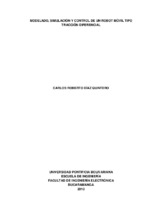| dc.contributor.advisor | Hernández Capacho, Carlos Gerardo | |
| dc.contributor.author | Díaz Quintero, Carlos Roberto | |
| dc.coverage.temporal | 2013 | |
| dc.date.accessioned | 2020-08-06T19:18:35Z | |
| dc.date.available | 2020-08-06T19:18:35Z | |
| dc.date.issued | 2013 | |
| dc.identifier.uri | http://hdl.handle.net/20.500.11912/5776 | |
| dc.description | 108 páginas | spa |
| dc.description.abstract | La simulación permite realizar estudios de comportamientos futuros sobre un modelo antes de realizar una creación física del mismo, aprovechando el tiempo y recursos al máximo a la hora de realizar la producción en masa del prototipo. La finalidad del proyecto es valerse de los beneficios de la simulación para crear el modelo de un robot móvil tipo tracción diferencial que permita el movimiento del robot desde un punto inicial hasta un punto final.
Para producir movimiento es necesario hacer un estudio dinámico de la estructura del robot. El estudio dinámico del modelo de simulación se realiza con el programa MSC ADAMS el cual permite evaluar de manera casi real las variables presentes en un cuerpo como lo es la inercia, peso, fricción, entre otras.
En el programa MSC ADAMS las piezas creadas no presentan un alto detalle visual por lo cual se utiliza el software CATIA mejorando ampliamente la visualización de las piezas y facilitando hallar los valores de masa e inercia que poseen diferentes tipos de materiales necesarios para evaluar su comportamiento en el movimiento del robot móvil. Estos valores se importan al programa ADAMS al igual que cada una de las piezas creadas para ensamblarlas en dicho programa y obtener el bloque de modelo de simulación.
La respuesta del robot móvil ante una trayectoria se ve mejorada al implementar un controlador, reduciendo así el error en posición. El software MATLAB/Simulink permite diseñar o aplicar controladores de manera sencilla y confiable. Para beneficiarse del potencial de estos dos programas, se establece una Co-Simulación entre ADAMS/MATLAB mostrando los resultados logrados al mover el robot móvil a través de una trayectoria Punto a Punto y una trayectoria Multipunto. | spa |
| dc.description.abstract | The simulation allows future conduct studies on a model before performing a physical creation of it, using the time and resources as possible to the time of making the mass production of the prototype. The goal of the project is to take advantage of the benefits of simulation to create the model of a differential steering mobile robot that allows movement of the robot from a start point to an end point.
To produce movement is necessary to make a dynamic study of the structure of the robot. The dynamic study of the simulation model is made with MSC ADAMS program which allows an almost real-evaluate the variables present in a body such as the inertia, weight, friction, among others.
The parts makes from MSC ADAMS program doesn't have a high visual detail, for this reason CATIA software is used widely to improve the visualization of the pieces and find the values of providing mass and inertia that have different types of materials needed to evaluate its performance in mobile robot motion. These values are imported into the ADAMS program as each of the pieces created to join them in the program and get the block simulation model.
The response of the mobile robot to a path is improved to implement a controller, thereby reducing the position error. The software MATLAB / Simulink permit to design or implement controllers simply and reliably. To benefit from the potential of these two programs, establishing a co-simulation between ADAMS / MATLAB showing the results achieved by moving the mobile robot trajectory through a point-to-point and multipoint trajectory. | eng |
| dc.format.mimetype | application/pdf | |
| dc.language.iso | spa | |
| dc.publisher | Universidad Pontificia Bolivariana | spa |
| dc.rights | Attribution-NonCommercial-NoDerivatives 4.0 International | * |
| dc.rights.uri | http://creativecommons.org/licenses/by-nc-nd/4.0/ | * |
| dc.subject | Simulación | spa |
| dc.subject | Robots | spa |
| dc.subject | Movimiento | spa |
| dc.subject | Sofware - Catia | spa |
| dc.subject | Software - Matlab | spa |
| dc.subject | Software - Simulink | spa |
| dc.title | Modelado, simulación y control de un robot móvil tipo tracción diferencial | spa |
| dc.type | Trabajo de grado | spa |
| dc.publisher.department | Escuela de Ingenierías | spa |
| dc.publisher.program | Ingeniería Electrónica | spa |
| dc.type.hasVersion | publishedVersion | spa |
| dc.description.sectional | Bucaramanga | spa |
| dc.description.degreename | Ingeniero Electrónico | spa |


